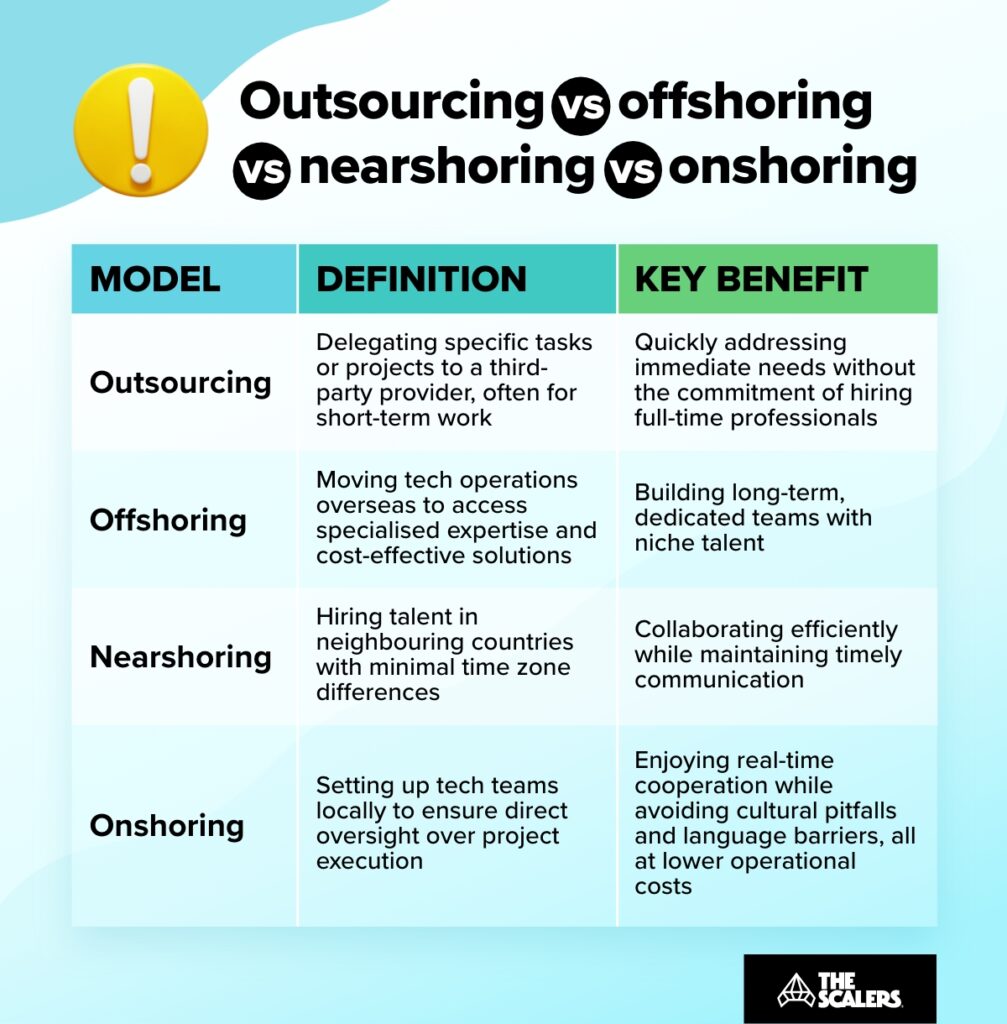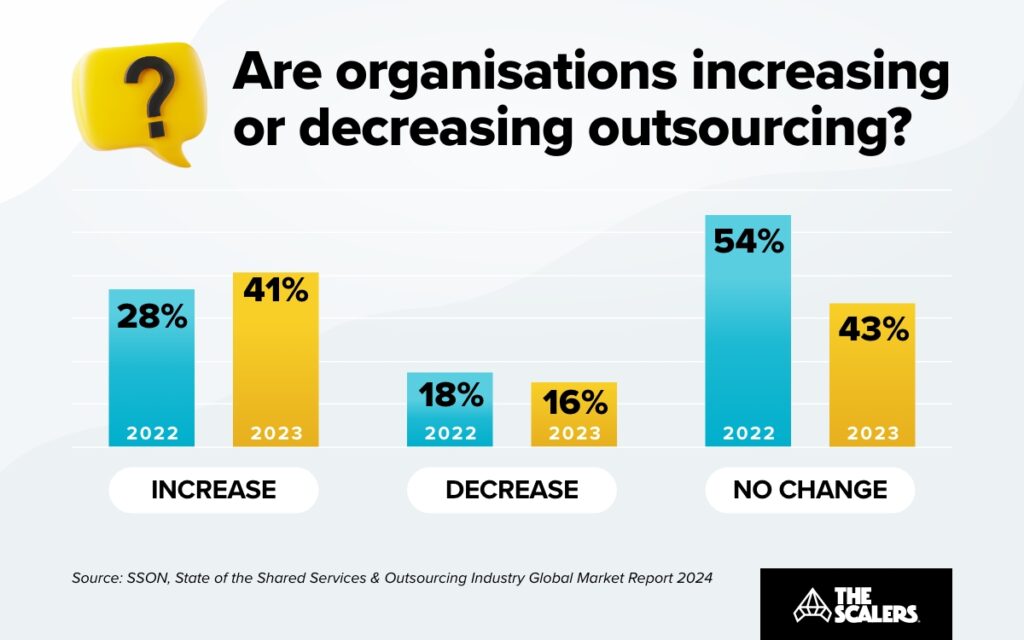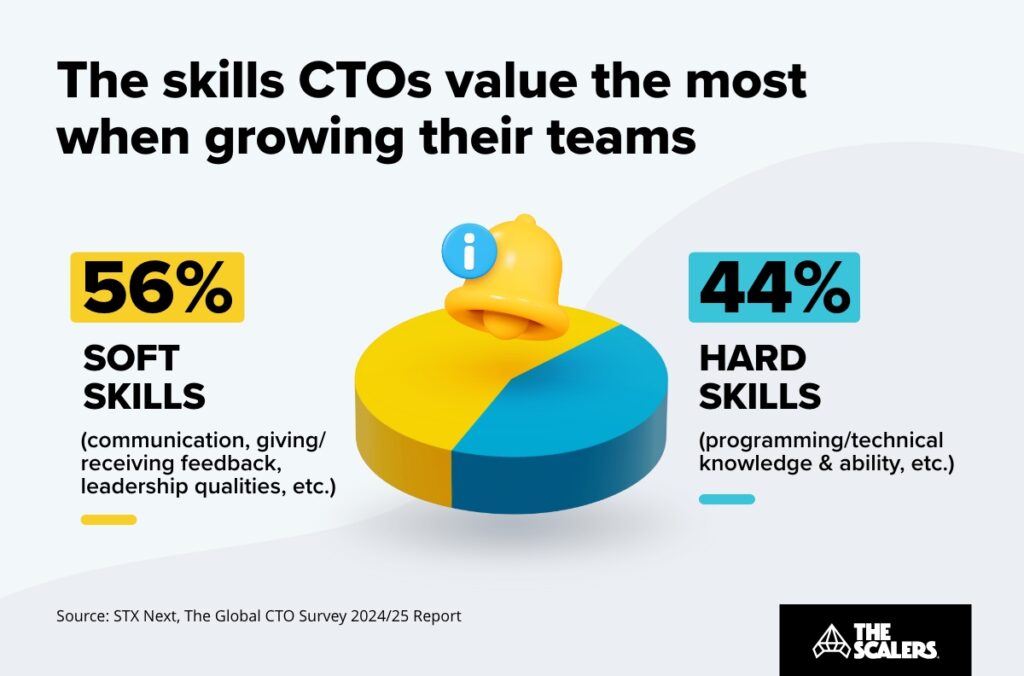Outsourcing vs offshoring vs nearshoring vs onshoring: Key differences

Tech and business leaders often mix up some of the most popular hiring and engagement models when considering building or extending their software development teams.
It might be your case. Perhaps you’ve always thought outsourcing and offshoring were the same, or you’ve tried to find niche-skilled professionals through onshoring, not realising it’s not the most effective approach.
We’ve written this article comparing outsourcing vs offshoring vs nearshoring vs onshoring to help you understand the differences and pros and cons between these models. After reading it, you’ll be able to make an informed decision about which option best fits your organisation’s requirements.
What is the difference between outsourcing, offshoring, nearshoring, and onshoring?
Outsourcing, offshoring, nearshoring, and onshoring share a common thread: they are all business practices that bring in specialised expertise or external talent that companies lack in-house.
But each serves different needs.

What is outsourcing?
Outsourcing involves engaging third-party vendors to deliver software or services on a contract basis. It’s a model suited for organisations seeking temporary assistance or engineers to complete short-term projects.
For example, you can outsource a team of three developers to fix bugs and provide support during the launch of a new feature in your app.
The professionals hired through outsourcing typically juggle multiple clients and aren’t fully dedicated to a single project; once they finish a task, they move on to another assignment.
What is offshoring?
Offshoring consists of relocating operations to another country to tap into niche skills and lower expenses, all while retaining complete oversight and control over the processes. This approach is ideal for companies seeking long-term partnerships.
For instance, you might choose to offshore software development to Bangalore, India, to access highly specialised developers and quickly scale your team and product offerings.
When done right, offshoring allows organisations to build dedicated teams with world-class talent, 100% committed and culturally aligned with their mission, vision, and values.
What is nearshoring?
As the name suggests, nearshoring means moving processes to a nearby country — typically within the same or a similar time zone — to take advantage of proximity while accessing skilled talent and reducing costs.
Nearshoring suits businesses that need constant, real-time collaboration with their team. If your organisation is headquartered in Paris, you might consider nearshoring to Ukraine, which is only an hour ahead.
What is onshoring?
Onshoring refers to the transfer of software development operations to locations within the same country, often in non-metropolitan areas.
Let’s say your company is located in London, where rent, bills, and wages are significantly higher than in other parts of the country. By building a development team in a nearby town instead, you can keep the operational costs a bit lower.
Plus, the talent you’ll be hiring will be local, so you’ll support the local economy while avoiding potential cultural misunderstandings.

Can’t find the skills you need at home? Stop searching and start scaling
LEARN MOREPros and cons of each model
Drawing from our experience building over 80 tech teams in the past 10+ years — and countless conversations with CTOs and business leaders — we’ve crafted an easy-to-understand list of the pros and cons of outsourcing, offshoring, nearshoring, and onshoring.
Outsourcing pros and cons
Pros
- Low costs: Outsourcing is known for its affordability. It’s typically used by companies aiming for short-term cost savings instead of hiring full-time staff.
- Efficient resource management: Outsourcing non-core tasks allows organisations to focus fully on their core strengths, improving efficiency and resource allocation.
- Flexible, project-based model: Since outsourced teams aren’t permanently employed, companies only pay for the work they perform. When demand decreases, no resources are wasted on idle workers. This flexibility benefits businesses with unpredictable capacity needs.
Cons
- Loss of control: Businesses generally have little control over project development when outsourcing. As a result, outcomes can be unpredictable, making it an unsustainable long-term strategy.
- Lack of ownership and innovation: When outsourcing, engineers focus solely on the tasks assigned to them, with no space for innovation. While they deliver with commitment, they don’t add extra value to the businesses they work for.
- Lack of customer focus: An outsourcing partner often serves multiple businesses simultaneously, leaving them without the time or focus to personalise offers. This can result in services that don’t meet the required standards.
- Hidden costs: While outsourcing may seem cost-effective, hidden costs can arise later for ‘out of scope’ work.

Offshoring pros and cons
Pros
- Access to top tech talent worldwide: Offshoring allows organisations to hire elite engineers from thriving tech hubs. India produces 1.5 million engineers annually, while Eastern Europe and Latin America are home to many highly skilled professionals.
- Ownership: Businesses have complete control over which developers are hired, what they work on, and when. A reliable offshore partner can help find and onboard top talent, but the company makes the final hiring decision.
- Long-term success: Offshore engineers are permanent employees rather than temporary hires for one-time projects. They are fully integrated into the business they work for and committed to its long-term success.
- Cost-effectiveness: Offshore developers command lower salaries than local or regional engineers while possessing a strong work ethic and niche programming skills.
- Round-the-clock operations: Offshoring offers a competitive edge with a global presence and 24/7 operations. Teams in different time zones ensure work continues even when in-house staff are unavailable.
- Scalability: Organisations can expand their offshore teams whenever needed to support growth and adapt to changing demands
Cons
- Geographical distance: Offshoring may not seem ideal because companies don’t share a similar time zone with their teams and are thousands of miles away from their headquarters. However, some of the best offshore partners facilitate collaboration through regular face-to-face meetings and leveraging modern task management and communication tools, making distance less of a concern while still providing access to top tech talent.

Nearshoring pros and cons
Pros
- Real-time collaboration: Nearshoring allows for real-time collaboration due to closer time zones. Teams can easily communicate and work together on projects.
- More frequent travel: Organisations can meet their teams in person more often due to the geographical proximity, shorter flights, and simpler travel requirements (e.g., no visa or easier visa processes).
- Simple regulations: Familiar laws and regulations in nearshore locations simplify compliance (e.g., nearshoring within the European Union offers standardised regulations and protections). However, this may not apply to all nearshore locations, so it’s important to thoroughly research the specific regulations of each destination.
Cons
- Limited talent pool: Organisations may find it difficult to find the right professionals in nearshore locations, due to the lack of niche tech talent in their neighbouring countries.
- Fierce competition for talent: Smaller talent pools in nearshore destinations lead to competition among companies for the same professionals, which reduces the chances of securing top-tier talent.
- High turnover rates: Nearshore engineers often leave or are replaced more frequently than those hired via long-term strategies like offshoring. Higher turnover rates result in inconsistent outcomes and subpar services.
Onshoring pros and cons
Pros
- In-person collaboration: Onshoring facilitates direct collaboration with team members, as they are located within the same city or country. This strengthens communication and fosters teamwork.
- No language barriers: An organisation that builds an onshore team will have engineers who speak their language, eliminating concerns about misunderstandings.
- Cultural compatibility: Being in the same region, businesses and onshore teams share cultural nuances, which avoids potential miscommunications.
Cons
- Lack of specialised tech talent: Onshoring isn’t the best option to find highly skilled professionals. That’s why many Western organisations weigh outsourcing vs offshoring to fill the talent gaps their local markets can’t cover.
- Higher costs: Given that onshoring implies building a tech team locally — presumably in Western locations like the US or the UK — the cost of hiring talent will likely be much higher than in offshore destinations. Businesses may save some money by transferring operations to a more affordable city within their country, but these savings are negligible compared to other hiring models.
So, what route to take?
Even after comparing outsourcing vs offshoring vs nearshoring vs onshoring, and understanding the pros and cons of each model, you might still be unsure which approach best suits your needs.
Let’s break it down:
- Outsourcing is for you if you need quick, project-based solutions without long-term commitments.
- Nearshoring is for you if you require real-time collaboration and value having minimal time zone differences with your tech team.
- Onshoring is for you if in-person collaboration and keeping operations locally are top priorities.
- Offshoring is for you if you want access to specialised, fully committed professionals and the ability to extend your team on demand as your business grows — all while keeping operations cost-optimal.

For Nextpoint — a leading company in the legal industry — the choice was clear. They weren’t able to find skilled engineers in their tech stack of Ruby on Rails, AWS, and JavaScript, so they turned to offshoring.
After some not-so-good experiences, they partnered up with us to build a dedicated development team in Bangalore, India. The results? We helped them build an 11-person team of in-demand specialists pivotal for the launch of their new flagship product.

Want to know more about The Scalers’ unique model and how we source, hire, onboard, and engage culturally aligned teams for our partners?
Fill out this form and tell us about your unique requirements. One of our senior executives will contact you shortly for a brief discovery call and, if there’s a fit, we’ll prepare a customised solution tailored to your needs and timeline.

offshoring that works
See how a top-rated meal delivery service finally got a properly distributed team
DOWNLOAD CASE STUDYIn summary
And it’s a wrap!
We hope you’ve found this article helpful and now have a clear overview of the differences, advantages, and disadvantages of outsourcing, offshoring, nearshoring, and onshoring.

If you enjoyed this guide and want to know more about offshoring and building tech teams, we recommend you read some of our related blog posts. You can find them right below the FAQ section!
FAQs
Can a business use a hybrid model combining offshoring and onshoring?
Absolutely. Many companies mix both to keep key roles local while building a specialised offshore team for long-term growth and cost savings.
Which are the best countries for offshoring?
India is one of the best countries for offshoring, given its massive talent pool of engineers who possess high English proficiency, deep technical specialisation, and tons of experience working with Western companies. Other popular destinations include the Philippines, Poland, and Colombia.
Which model is the most cost-effective: offshoring, outsourcing, nearshoring, or onshoring?
Offshoring is the most cost-effective model because you get access to highly skilled talent at competitive rates. With the right partner, you can hire dedicated engineers who feel like part of your in-house team.
Why do companies choose offshoring over other delivery models?
Because, unlike other models, offshoring allows them to build dedicated development teams with engineers who are fully aligned with their goals and work like true extensions of their business.















